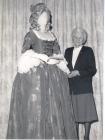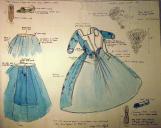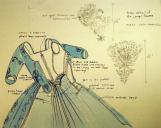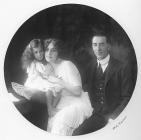1
View of English open robe gown, circa 1780.Circa 1780
Costume Museum of Canada, Winnipeg, Manitoba, Canada
 Credits:
Credits:Costume Museum of Canada
2
The Costume Museum's 'Tucker Dress', gown is thought to have been worn by Aletta Riddell who journeyed to Bermuda from Scotland to marry Captain Henry Tucker in the 18th century. The Tucker family had been settled in Bermuda since 1616 and Captain Tucker became Governor for the Bermuda Company. The dress was donated to the Costume Museum by Mary Tucker of Winnipeg in 1983. Mary was the wife of Major Park Benjamin Riddell Tucker (b.1876), who had been sent to school in Canada in 1890 at age 14 following the death of his parents and who brought dress with him as part of his inheritance.3
Winnifred Van Slyck with restored English open robe gown.Circa 1990
Dugald, Manitoba
 Credits:
Credits:Costume Museum of Canada
4
Knowing that they did not have the capacity to perform the restoration the dress required, the museum applied in 1986 to have the dress conserved at the Canadian Conservation Institute. The Institute consulted with Dr. A. Ribeiro, head of London's Courtald Institute. Dr. Ribeiro concluded that the brocade fabric of silk with metallic threads was woven in France around 1720 while the gown was made up in England around 1780. It was not unusual for fabrics of this calibre to remain stored in warehouses for decades before being sold.5
Tucker Dress drawing by Winnifred Van Slyck.Circa 1985
Costume Museum of Canada, Winnipeg, Manitoba, Canada
 Credits:
Credits:Costume Museum of Canada
6
Tucker Dress drawing by Winnifred Van Slyck.Circa 1985
Costume Museum of Canada, Winnipeg, Manitoba, Canada
 Credits:
Credits:Costume Museum of Canada
7
Tucker Dress drawing by Winnifred Van Slyck.Circa 1985
Costume Museum of Canada, Winnipeg, Manitoba, Canada
 Credits:
Credits:Costume Museum of Canada
8
This rare gown would have been worn for formal occasions of lavish evening entertainment. It is one of the Costume Museum's most treasured artefacts.9
View of English open robe gown, circa 1780.Circa 1780
Costume Museum of Canada, Winnipeg, Manitoba, Canada
 Credits:
Credits:Costume Museum of Canada
10
Elizabethan Table Napkin, circa 1560.Circa 1560
Costume Museum of Canada, Winnipeg, Manitoba, Canada
 Credits:
Credits:Costume Museum of Canada
11
A donation to the Dugald Costume Museum of several textile artifacts included a linen damask weave table napkin possibly used by Queen Elizabeth I, ca.1559 and passed down to the donor from the Holmes family. The donor's grandfather, Robert Lancelot Carr (b.1863), came to Canada from Maidstone in 1884/85 and was part of a force dispatched to put down the Riel Rebellion in Saskatchewan.12
Portrait of Ofelia Fabiani, Sveva and Leone Caetani taken just before their departure for Canada.Circa 1920
 Credits:
Credits:Accession # 1996.063.624, Sveva Caetani collection, Greater Vernon Museum and Archives
13
Leone Caetani, Duke di Sermoneta and Prince of Teano (born 1869) and Ofelia (Fabiani) Caetani (born 1896) lived the privileged life of Italian aristocrats. The Caetani family can trace their ancestors to the 8th century B.C.E. and include among them two Popes. Duke Leone was also a renowned scholar and historian of Islam who contributed to the production of the 10 volume reference work Annals of Islam, still a standard reference text. Duke Leone and Ofelia, Leone's second wife, had one child - a daughter born in 1917. The social changes which followed WW I precipitated a drastic reduction in the Caetani family fortunes and Duke Leone responded by relinquishing his titles to his brother Roffredo and abandoning his Islamic studies. The family immigrated to Canada along with their Danish secretary, 'Miss' Juul (who was a companion to Ofelia Caetani), and settled in the B.C. interior near Vernon, B.C.14
Family friend modelling items from Caetani donation.Circa 1995
Vernon, B.C.
 Credits:
Credits:Costume Museum of Canada